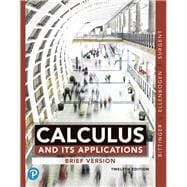NOTE: Before purchasing, check with your instructor to ensure you select the correct ISBN. Several versions of the MyLab™ and Mastering™ platforms exist for each title, and registrations are not transferable. To register for and use MyLab or Mastering, you may also need a Course ID, which your instructor will provide.
Used books, rentals, and purchases made outside of Pearson
If purchasing or renting from companies other than Pearson, the access codes for the MyLab platform may not be included, may be incorrect, or may be previously redeemed. Check with the seller before completing your purchase.
For one-semester courses in Applied Calculus.
This package includes MyLab Math.
Anticipating and meeting student needs
Calculus and Its Applications, Brief Version remains a best-selling text because of its intuitive approach that anticipates student needs, and a writing style that pairs clear explanations with carefully crafted figures to help students visualize concepts. Key enhancements in the 12th Edition include the earlier introduction of logarithmic and exponential functions to help students master these important functions and their applications.
The text’s accompanying MyLab™ Math course also has been revised substantially, as new co-author Gene Kramer (University of Cincinnati, Blue Ash) revisited every homework question and learning aid to improve content clarity and accuracy. These and all other aspects of the new edition are designed to motivate and help students more readily understand and apply principles of calculus.
Note: The title of this text was formerly Calculus and Its Applications.
Personalize learning with MyLab Math
By combining trusted author content with digital tools and a flexible platform, MyLab Math personalizes the learning experience and improves results for each student.
0135308038 / 9780135308035 Calculus and Its Applications, Brief Version, Plus MyLab Math with Pearson eText - Title-Specific Access Card Package
Package consists of:
- 0135164885 / 9780135164884 Calculus and Its Applications: Brief Version
- 0135256267 / 9780135256268 MyLab Math with Pearson eText - Standalone Access Card - for Calculus and Its Applications: Brief Version











